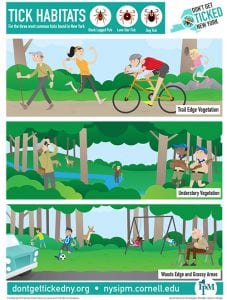You’ve all heard about them, right? Yeah, the little buggers sneak up on you, bite you, and—maybe—make you sick. Sometimes really sick.
They’re not really bugs, of course, but tiny eight-legged critters remotely related to spiders but without the benefits spiders provide. (Note that adult females plump up like small grapes once they’ve satisfied their appetite.)

For today, we’re considering blacklegged ticks, aka the deer tick—the name it was christened with years ago, before entomologists realized that tick is already here; has been for thousands of years—and it already has a name. Yes, we’ve got a couple of other ticks we can’t ignore. But that’s for another day.
So … the best reason for ditching the name “deer tick”? It suggests deer are the problem. OK, blacklegged ticks do infest deer and deer can travel widely, so yes, they carry them around in the literal sense and ticks will drop off here, there, most anywhere. But no, deer don’t vector (aka “carry”) Lyme disease. Look to mice, chipmunks, and shrews for that.
So. Back to the topic at hand. The youngest ticks are six-legged larvae, the size of the period at the end of this sentence—and with one exception, they don’t vector disease. (More on that in another post.) After they feed on, say, a mouse or robin, they morph into nymphs and grow as large as poppy seeds. Since poppy seeds with legs are still darn small, they’re the ones that most often nail us.
And the adults? They’re more likely to vector Lyme and the co-infections that too often accompany it or act in its stead. After all, ticks have adapted to be secretive; to keep from being detected. But since by now they’re the size of sesame seeds—still small, yes, but easier to see—you’re more likely to get shed of them before they do damage.
No matter which life stage they’re at, know how to protect yourself. Because you can’t count on feeling them crawling on you. Here’s the countdown:

Recognize and avoid tick habitat. Tick species differ in where they prefer to hang out, but it’s possible to come too close for comfort to a tick anytime you leave the pavement. Sure, some parts of the state are home to orders of magnitude more ticks than others are, but that’s no reason to think you’re immune to those nasty little critters catching you unawares. And it’s so easy to be unaware.
Daily Tick Check! Regardless how careful you are, you won’t manage to steer clear of ticks 100 percent of the time. Perform daily tick checks even if you haven’t been outdoors in a day or so. Get to know the spots and bumps on your skin so you can recognize new ones. New ones that just happen to have legs.
Dress the part. If you’ll be in tick habitat (meaning you step off the pavement), take precautions by wearing light-colored, long pants tucked into your socks and a light-colored shirt tucked into pants. It’ll be easier to see ticks crawling on you and more difficult for ticks to get to your skin.

Use repellents. Here’s more on choosing the right repellent. and this guide from Consumer Reports.
Remove ticks safely. Only one method has been officially evaluated for its ability to safely remove ticks — using sharp tweezers, grab a tick as close to the skin as possible and gently pull up. Other methods could increase the risk of acquiring a tick-borne disease. To learn more, see “It’s tick season. Put away the matches.”
Which is all we’ll say for now, other than on August 7 we’re hosting a statewide conference on—you guessed it—ticks. Oh … and skeeters, too:
- Breaking the Cycle: Integrated Management of Ticks and Mosquitoes
- Tuesday, August 7, 2018, 9 AM
- Westchester County Center, 198 Central Ave, White Plains, New York